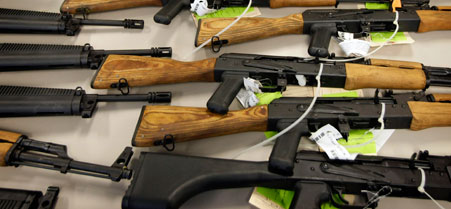Can technology predict gun crime? ATF hopes so.
 Matt York/AP
Matt York/AP
The Bureau of Alcohol, Tobacco, Firearms and Explosives is shopping for crime forecasting technology to predict where gun violence may occur so that ATF can intercede before it happens.
The Justice Department on Thursday issued a solicitation for a system "designed to accurately identify the risk of personal and property crimes" covering 200 locations throughout the United States, United Kingdom and Canada.
Software will display color-coded crime risk maps with interactive features for locations that are identified as high risk, according to the work description . The technology will interpret the current and changing demographics of communities to produce trend analyses. It will be able to generate online reports for an unlimited number of users at government agencies and businesses.
"It's a step forward for ATF," said Paul Wormeli, executive director emeritus at the Integrated Justice Information Systems Institute. "I'm delighted to see that they're thinking about how they can do this better." State and local police already are using geolocational information to perform some of the same kinds of predictive analyses described in the solicitation, he noted.
Wormeli expected the technology one day could augment forecasts with smartphone text messages, video and other observations from witnesses and good Samaritans out in the field. "We spend a lot of money getting officers to the scene of an incident," but dispatchers using "citizens as sensors" can save officers trips by collecting video from people at the scene of a crime, he said.
One of the big movements in law enforcement is place-based policing, often called "proximity-based policing," rather than person-based policing, Wormeli said.
In 2004, according to Justice officials , ATF and local police cracked down on "areas infested with gang and narcotic activity" in Las Vegas by comparing several location-based data sets: geographic areas where firearms were recovered; the records of Las Vegas' three biggest, licensed firearms dealers; and local police statistics on the addresses of homicides, robberies and related violent gang activity. Once authorities had narrowed in on the crime hot spots, they embedded informants to find the kingpins.
Essentially, authorities were using the criminal history of locations to predict where offenders would strike next and nab them before anyone got hurt. As a result of the effort, "154 guns and 58 of the worst-of-the-worst criminals were arrested," stated a 2006 Justice report. One investigation contributed to the "discovery of 15 homemade machine guns following the controlled purchase of four from the suspect." Separately, an interstate murder-for-hire plot was uncovered, leading to federal charges against a man who had several pipe bombs in his house.
In June 2011, Justice announced that analytical software paved the way for seven new arrests, 18 arrests on outstanding warrants and an assault rifle seizure -- during one week in northern Ohio. The enforcement activity was part of the kickoff of an initiative called V-GRIP, or Violence Gun Reduction and Interdiction Program, aimed at taking illegal firearms off the streets. State, local and federal officials shared intelligence and used crime-mapping software and other technology to target specific neighborhood crime hot spots.



